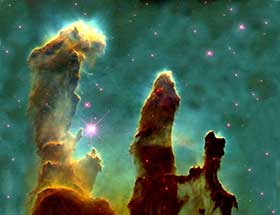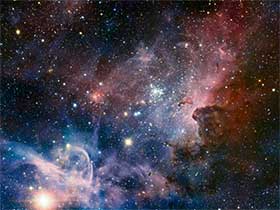
Light on the Dark Side: Images
and Reflections from Outer Space
- Phil MacGregor
_______________________________

Fig. 4. The Pillars of Creation, 2003 

Astronomy is among the most illustrated topics in science in the Press — 54 percent of meteorological stories had pictures, according to Bucchi and Mazzolini, (Ibid). Although this finding applied only to Italy, it is reasonable to assume that the proportion might be replicated elsewhere. Dutt and Garg [8] found that in 1996 the astronomy stories in Indian English-language papers were the most abundantly supplied with visual material of all the science topics they analysed. Almost 100 percent of items had either drawing, graphic or photograph.
The quality and analysis of pictures in astronomy has barely been debated in the literature about journalism. Many are attractive to look at, which in my view, is one of their most striking features, inviting analysis of pictorial qualities. Only a small proportion of texts about journalism focus on aesthetics. Åker [9] records how still and moving images have been primarily investigated for their contribution to the realm of journalistic professional mythologies such as objectivity ideals, and the role images play as “evidence” and to convey “realism.” One exception focuses on an image from the Hubble telescope interpreting the image The Pillars of Creation (fig. 4) in which Greenberg [10], showed how public reception of the image strayed from either the scientists' intended meaning or the one espoused by some media. In this case people began to see iconic religious images among the pictured forms.
It is unusual to link photography in news to art, but Åker (art. cit., 326) proposes that a new genre of newspaper photograph is emerging, which is not concerned with evidence or drama but that relays everyday events and connects with artistic traditions. Such ideas, he says, are complicated by traditions of photorealism because at the turn of the 20th century art was defining itself against what was perceived to be the mindlessness of mechanical reproduction achievable by photos. He is fascinated by a new type of photograph sometimes given to front pages, “aesthetically pleasing…often enigmatic” images, of everyday life, neither sensational nor evidential. He believes digitization is changing the nature of public reception of journalism and photographic images and the type of images they want. The public are savvy, understand that analogue techniques and objectivity ideals went together, and that they are dissolving. He suggests that digitisation and a photo-op culture have led people to understand that photographs are “interpretations and constructions of reality and not parts of it.” The relevance of this perspective is that it admits that content has a news value (a reason for content inclusion) that connects with aesthetics and art, and also that consumer preferences are affected by the technologies of production and delivery.
So far, then, we can see only occasional reference to the aesthetic side of pictures in the press, or to the content of space photography. Picture analysis has been limited to the traditional concerns of journalism with its mythologies of truth and evidence, and has barely touched on concerns of artistic content.
It follows that to pursue a discussion specifically on aesthetics, it is necessary to look at literature outside journalism studies. On space imagery itself, the ground was broken by Lynch and Edgerton [11]. They made important observations, including the point that the image creators worked both in an artistic and scientific dimension and thus innovated in the way they connected culture and science. For the science, the criterion of self-assessment of the technical and scientific digital imaging process was to clarify the data from astronomical instruments to reflect different physical properties of the objects examined.
Choices of colour palettes (they didn't mention shapes) depended on the ability to clarify data to reflect the intensities, energy levels and wavelengths of received information. The choice of colours was ultimately arbitrary, and was decided on by a host of factors including, when they wrote, the limitations of software.
It must be realized that in some space imagery there is no visual object to depict and often limited possibility of representational realism. Much visual imagery we receive through scientific channels represents what is actually extra-sensory. Radio astronomy arrives in digital form and relays wavelength data that technicians and scientist translate into shapes and colours visible to the eye. When working as scientists rather than as artists, the image makers' aim is to represent data in terms of truth to scientific reality — a task of enhancement that brings its own challenges, as Elkins [12] notes. All these kinds of images only indicate formal properties of the data, not the direct effect of the data on the human retina if an observer had been in range. So the colours used for that kind of work depend on human choice since the technicians represent something that could never be seen with the naked eye, or, at least, not in the form the data was received.
Lynch and Edgerton (Ibid.) discovered that there are some naturalistic elements to the very loose conventions the astronomers choose for their art-style images — for example, in one option, blue and black represent dark sky, while saturated reds, whites, and yellows indicate intense sources. Another naturalistic option is to arrange colours into the spectral sequence from red to indigo and violet, in which case red depicts long wavelengths and blue denotes X-ray or similar sources.
Cameras in space only record in certain wavelengths, meaning that the NASA scientists and technicians are interpreting what is received into colour sequences. Hubble records in black and white. Hubble technology then applies colour filters to the images and transfers the black and white into simple colours like red and blue, a process succeeded by another stage when the astronomers enhance the results with further colours. For the composite images of the Carina nebula (fig. 5), for example, the Hubble images recorded wavelength intensity in black and white, while the colour filters used were supplied in images taken by a ground-based telescope in Chile. As explained by Zoltan Levay [13], the team lead for the Office of Public Outreach at the Space Telescope Science Institute in Maryland, the colour choices today are less naturalistic than 20 years ago. Blue, he says, represents high energy objects like stars in formation, while lower frequencies tend to be recorded in red. The final result in the Carina is a mosaic of many exposures from multiple points of view with colour information supplied from terrestrial telescopes).
So we can see that colour is only an analogy for representational accuracy, which is by definition malleable. How one defines naturalism in this digital reconstruction is open and strongly determines the final aesthetic.
[8] Bharvi Dutt and K. C Gharg, “An Overview of Science and Technology Coverage in Indian- English-Language Dailies,” Public Understanding of Science, Vol. 9, 2000, pp. 123-140.
[9] Patrik Åker, “Photography, Objectivity and the Modern Newspaper,” Journalism Studies, Vol. 13 N° 3, 2012, pp. 37-41.
[10] Joshua Greenberg, “Creating the ‘Pillars’: multiple meanings of a Hubble Image,” Public Understanding of Science, Vol. 13, 2004, pp. 83-95.
[11] Michael Lynch and Samuel Edgerton, “Aesthetics and Digital Image Processing: Representational Craft in Contemporary Astronomy,” in Picturing Power: Visual Depiction and Social Relations, Gordon Fyfe and John Law (eds), London, Routledge, 1988, pp. 184-215.
[12] James Elkins, Six Stories from the End of Representation, Images in Painting, Photography, Astronomy, Microscopy, Particle Physics, and Quantum Mechanics 1980-2000, Stanford, Stanford University Press, 2008.
[13] Zoltan Levay, presenter, How the Hubble Space Telescope’s stunning colour photographs are created – video on The Guardian's internet site (accessed July 3, 2014).


